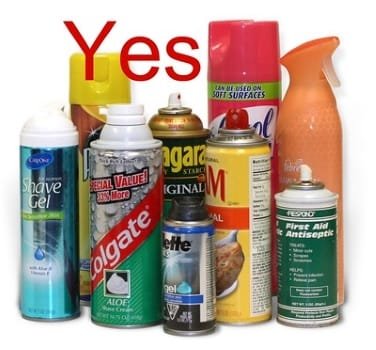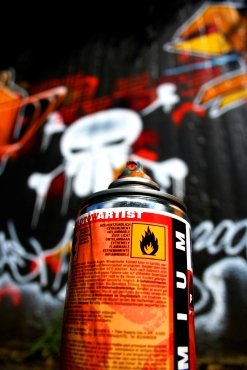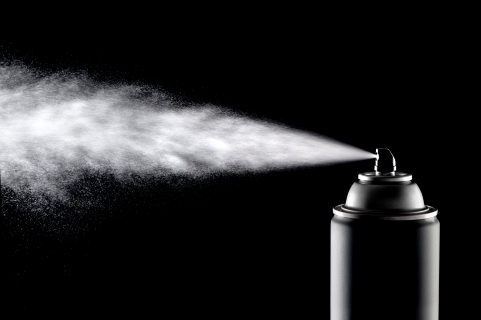If you’re an anxious traveler or simply flying someplace for the first time, you would be surprised to know that several household items that we wouldn’t think twice about while packing would not even make it past the TSA security checkpoint.
Surely you would think that something like a deodorant would be essential for everyone (although we have our suspicions that not everyone agrees with us!). This article does humanity a favor by answering all your aerosol-related questions. Will aerosol cans explode in checked luggage? Don’t worry, there’s only a minuscule chance of that happening, so you can carry and travel with deodorants (and other aerosols) safely, although some rules apply.
Table of Contents
Can you Fly With Aerosols in Checked Baggage?
Yes, you can fly with aerosols in checked baggage. Aerosols can come under the category of either medicines or toiletries. Deodorants, inhalers, hairsprays, and perfumes are all examples of typical aerosols.
That said, the Federal Aviation Authority has certain limitations on the quantity, size, and capacity of aerosols you pack into your luggage. The total amount of such items cannot exceed 2 kg (or 2 liters) in your checked luggage. Each aerosol container has a maximum limit of 0.5 kg (0.5 liter or 17 ounces).

The nozzle or opening of each canister should be tightly packed or closed to avoid any accident or leakage inside the airplane. In case you need to use an aerosol during the flight, please get in touch with the crew on-flight first.
How Many Aerosol Cans Can I Take on a Plane?
Rather than the quantity, there is a limit to the capacity and size of each container of aerosol that you can bring on the airplane. As mentioned above, there is an upper limit of 2 kg, with each item no more than 0.5 kg.
However, certain aerosols that are flammable are prohibited from being packed into your luggage at all. Aerosol containers without lids are also banned as there is a risk of leakage mid-flight. They will be confiscated during the security check in case you do pack them.
Can you Take Aerosols in Carry on Baggage?
Carry-on bags have more restrictive baggage rules placed on them. Aerosols come under the liquid allowance category, therefore any aerosol can should be no more than 3.4oz/100 ml in capacity. You will also have to fit it into a single quart-size bag along with the other liquids that you may need.
It is better to pack your aerosols in checked baggage instead, so you don’t have to deal with any size restrictions. However, many brands have also started selling travel-friendly aerosols such as deodorants and shaving foams that come in bottles smaller than 100 ml and can pass the TSA security check with minimum problems.
What Aerosols Are Not Allowed on Planes?
Unfortunately, the restrictions on aerosols are not just limited to size and capacity.
There are many different types of aerosols not allowed or restricted, ranging from whipped cream to hair spray and pepper sprays to spray paint, and all have different rules on whether they’re allowed or not.
To break it down for you, all aerosols that fall in the category of toiletries and medicines such as deodorants, shaving cream, skin application bug repellents, and perfumes are allowed in both carry-on and checked luggage, as long as they conform to size restrictions.
All types of flammable aerosol cans, such as spray paint and WD-40, are strictly prohibited. A handful of non-flammable items such as whipped cream or pepper sprays can be allowed when packed in your checked luggage as long as they’re not labeled as a hazardous material.
How to Pack Aerosol Cans for Flying
After you’ve ensured that the aerosol can you’re carrying is permitted for flying, it’s time to address the next big question.
All aerosol cans should be packed such that no accidental leakage occurs. No aerosols without lids are allowed, and it is recommended that you tape shut the nozzle of the cans to prevent accidental release.
Aerosol cans in your carry-on should be placed in a single-quart, transparent zip-lock bag. Only as many 3.4 oz. cans are allowed that can be sealed in that bag (the 3-1-1 rule).
There are no specific rules for packing aerosols in your checked luggage. However, you can make sure to tuck the cans safely along with items to prevent them from rolling or rocking about in your luggage. Use these tips for packing toiletries in checked luggage.
Can I Take Gas Canisters on a Plane?
Filled gas canisters are strictly not allowed on a plane. These include CO2 cartridges used for carbonating drinks.
If you are traveling with an empty gas canister, it should be disconnected to allow security officers to check whether it’s open or not.
The only exception to this rule is for people with medical conditions who need to travel with a compressed oxygen cylinder. The security offers will make sure that the regulatory valve has not been tampered with.
Why do Aerosol Cans Explode if Heated?
Aerosol cans are made using propellant gases. When heated, the liquid molecules gain energy and eventually become gas. This drastically increases the pressure inside the can. To achieve equilibrium, this gas ‘explodes’ or bursts out of the can. It takes a rise of 30°C to double the pressure inside a can.
Dangers of Aerosol Cans and Fire on an Airplane

From lift-off until the time you arrive at your location in an airplane, the temperature, and pressure inside an aerosol can can change drastically. These cans are already highly pressurized, and any temperature change can further increase the pressure within, leading to explosions, as mentioned above.
Only open flames are usually dangerous enough to lead an aerosol can to the point of explosion. Since open fires are a rare occurrence in airplanes, this is something you generally do not have to worry too much about.
However, certain specific conditions can also lead to such explosions. In an experiment conducted by the FAA, when an aerosol can was kept near a lithium-ion battery (often present in laptops) and it was heated up rapidly, it resulted in the explosion of the can and fire. Such a fire cannot be put out by the average on-flight fire extinguisher system.
However, keeping to an 18-ounce or smaller aerosol can (the limit set by TSA for a single one) helps avoid such accidents. Since it is difficult to control the nature of items you travel with, it is essential to strictly abide by the restrictions on the type and quantity of articles set by TSA to ensure safety while traveling.
Safer Alternatives if You’re Unsure
If you want to be on the safe side while flying, most aerosol toiletries can be substituted by liquids or creams. Even though these still come under the liquid rule for hand luggage, there are no restrictions for checked luggage, as there’s no danger of bottles of normal liquids exploding.
Instead of a spray, some dry shampoos come in paste form. Or you could just fly with regular shampoo, even though you still have to pack it properly so that it doesn’t leak when you’re flying. Similarly, insect repellents are available in lotion or gel form. Deodorants are available in dry stick or roll-on liquid form. Most brands make travel-sized roll-on perfumes and non-pressurized spray bottles.
If you’re flexible with regards to your toiletries, you can easily avoid carrying aerosols while flying and rest easy knowing that nothing will be confiscated or will be less likely to make a mess all over your clothes in your checked luggage.

